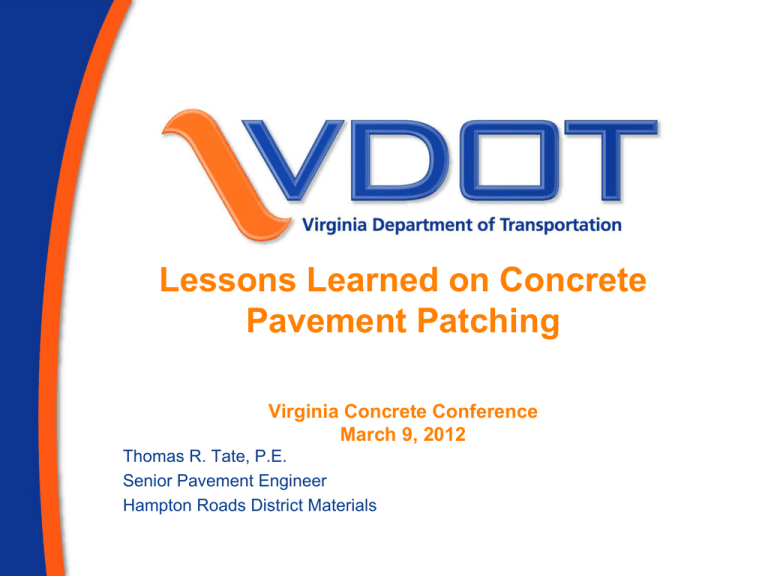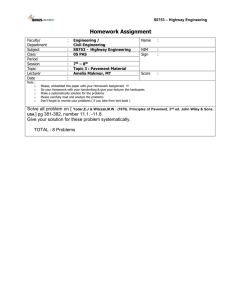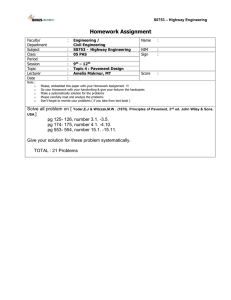Thomas R. Tate
advertisement

Lessons Learned on Concrete Pavement Patching Virginia Concrete Conference March 9, 2012 Thomas R. Tate, P.E. Senior Pavement Engineer Hampton Roads District Materials Project Development • • • • • Determine needed patch types How to set patch limits Establish accurate(?) quantities Include patch locations Traffic control, lane closure considerations (MOT) 2 Project Development In the beginning: • Identify (see) need • Identify project limits • Pavement evaluation • Scoping meeting • Develop contract 3 Project Development Identify (See) Need • Low pavement rating (low CCI) • Rough pavement • Failing joint sealant • Visible distresses • Poor maintenance history • Customer complaints 4 Project Development Identify Project Limits • Original construction project limits • Change in pavement type • Change in pavement width • Limit by physical boundaries • Set limits by funding 5 Project Development Pavement Evaluation, Why? • Determine existing pavement thicknesses (mainline, shoulders, concrete thickness/type, base thickness/type, subgrade condition, etc.) • Determine cause of observed distresses • Determine structural capacity of existing pavement layers • Condition of bases • Condition of subgrade • Material reactions? • Drainage issues? 6 Project Development Scoping Meeting Bring all stake holders together • Funding (Maintenance or Construction) • Materials • Design • Construction • Traffic Engineering • Structure & Bridge • Operations • Others 7 Project Development Develop Contract • Determine needed patch types • How to set patch limits • Establish accurate(?) quantities • Include patch locations • Traffic control, lane closure considerations (MOT) 8 Project Development Determine Needed Patch Types Patch Type JCP Type I X Type II X Type III X CRCP Type IV X Anchor Slab X Approach Slab X X 9 Project Development Patch Limits Jointed Concrete Pavement (JCP) Types I & II • Minimum 6 ft long • Full lane width (12 ft) • Minimum 1 ft past/beyond distress (failed joint, pot hole, failed crack, etc.) • Minimum 1 ft past/off existing joint • Minimum 10 ft between patches 10 Project Development Patch Limits Continuously Reinforced Concrete Pavement (CRCP) Type IV • Minimum 6 ft long • Full lane width (12 ft) • Minimum 1 ft past/beyond distress (punch out, asphalt patch, cluster cracks, Y-cracks, etc.) • Minimum 1 ft past/off existing transverse crack • Minimum 10 ft between patches • Headers? 11 Project Development Accurate Quantities • Patching • Joint Sealing • Crack Sealing • Slab Jacking • Shoulder Rehab • Traffic Items (Guardrail, Pavement Markings, etc.) Know Limits of Work!!!! 12 Project Development Accurate Quantities Patching – Estimating Quantities • Shoulder survey (walk or in vehicle) • Video survey • Sample survey • Others? 13 Project Development Severity level 2 cluster cracking – patch. 14 Project Development Severity level 1 cluster cracking 15 Project Development Accurate Quantities Patching • Work will be done one or more years after estimated • What is purpose of patching? • Will the concrete pavement be left exposed or will it be overlaid? • Expect quantities to increase from time of estimate until pavement is actually patched (how many more winters will pavement go through?) 16 Project Development Patch Locations • Near other patches • Near bridges or overpasses • Near or within interchanges • At pavement changes 17 Project Development Traffic Control/Lane Closure Considerations • Limitations of Operations (LOO) • Will a waiver of standard LOO be needed • Is there other work going on or planned in general vicinity of project? • Operations (Tunnels, Bridges, TOC) 18 Project Development Special Provisions or Copied Notes for: • Concrete Patching • Concrete Grinding • Re-Sealing Joints • Sealing Joints or Cracks • Rideability • Asphalt Work • XJ-1 Joints 19 Project Development Questions? 20




